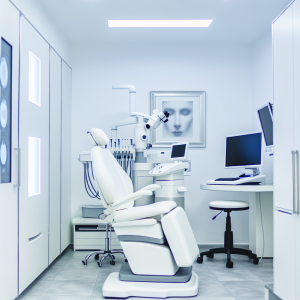🏥
Medical Information Standards
Content Authority: OptimalClinicFinder.com is a comprehensive medical directory platform connecting patients with qualified Hormone Replacement Therapy providers. Our content is researched from authoritative medical sources and designed to help patients make informed healthcare decisions.
What is Hormone Replacement Therapy and How Does it Work?
Hormone Replacement Therapy (HRT) is a medical treatment designed to supplement or replace hormones that your body no longer produces in adequate amounts. This therapy works by introducing synthetic or bioidentical hormones into your system to restore optimal hormonal balance and alleviate symptoms associated with hormonal deficiencies.
The mechanism of action varies depending on the specific hormones being replaced. For estrogen and progesterone therapy, hormones bind to specific receptors in target tissues, activating cellular processes that regulate everything from bone density to mood regulation. Testosterone replacement therapy works similarly, binding to androgen receptors to influence muscle mass, energy levels, and sexual function.
💡
Did You Know?
Clinical studies show that Hormone Replacement Therapy patients achieve excellent results when combined with professional-grade aftercare products.
FDA-Approved Uses and Applications
The FDA has approved hormone replacement therapy for several specific conditions:
Menopausal Hormone Therapy
The most common FDA-approved use is for treating menopausal symptoms in women. This includes hot flashes, night sweats, vaginal dryness, and mood changes associated with declining estrogen levels. The therapy can significantly improve quality of life for women experiencing moderate to severe menopausal symptoms.
Testosterone Replacement Therapy
FDA-approved for men with clinically diagnosed hypogonadism (low testosterone), this treatment addresses symptoms like decreased libido, fatigue, muscle loss, and mood changes. Diagnosis requires documented low testosterone levels through multiple blood tests.
Thyroid Hormone Replacement
For individuals with hypothyroidism, thyroid hormone replacement therapy is essential for maintaining proper metabolism, energy levels, and overall health. This is typically a lifelong treatment requiring regular monitoring.
💡
Quick Tip
Hormone Replacement Therapy works best when combined with healthy lifestyle choices for optimal results.
Common Off-Label Uses
Healthcare providers may prescribe hormone replacement therapy off-label for various conditions including age-related hormone decline, certain mood disorders, osteoporosis prevention, and sexual dysfunction. While these uses show promise, they require careful consideration of risks and benefits.
The Consultation Process
A comprehensive consultation for hormone replacement therapy involves several critical steps:
Initial Assessment
Your healthcare provider will conduct a thorough medical history review, including current symptoms, family history, medications, and previous treatments. This assessment helps determine if you’re a suitable candidate for HRT.
Comprehensive Testing
Blood work is essential to establish baseline hormone levels. Tests typically include estradiol, progesterone, testosterone, thyroid hormones (TSH, T3, T4), and other relevant markers. Some providers may also order additional tests for liver function, cholesterol, and blood clotting factors.
Physical Examination
A complete physical exam helps identify any contraindications to hormone therapy. For women, this may include breast and pelvic examinations. For men, prostate health assessment is crucial.
✓
Why Choose Hormone Replacement Therapy?
●
Clinically proven
●
FDA approved
●
Minimal downtime
●
Long-lasting
Treatment Planning
Based on your test results and symptoms, your provider will develop a personalized treatment plan. This includes hormone selection, dosage, delivery method, and monitoring schedule. The plan should align with your health goals and lifestyle preferences.
Treatment Delivery Methods
Hormone replacement therapy can be administered through various methods, each with distinct advantages:
Oral Medications
Pills are convenient and familiar to most patients. However, they must pass through the digestive system and liver, which can affect hormone levels and increase certain risks.
Transdermal Patches
Patches deliver hormones through the skin, bypassing the digestive system. They provide steady hormone levels but may cause skin irritation in some patients.
Topical Gels and Creams
These allow for flexible dosing and easy application. Bioidentical hormone creams are particularly popular for their customizable formulations.
Injections
Intramuscular injections provide consistent hormone levels over extended periods. They’re particularly common for testosterone replacement therapy.
🏆
Verified Providers Only
All our directory providers are licensed, experienced, and patient-safety focused.
Pellet Implants
Subcutaneous pellets release hormones gradually over 3-6 months. They offer the most consistent hormone levels but require minor surgical procedures for insertion.
Recovery Timeline and Aftercare
The response to hormone replacement therapy varies significantly among individuals:
Initial Response (2-4 weeks)
Many patients notice initial improvements in energy, mood, and sleep quality within the first month. However, full benefits may take longer to manifest.
Optimization Phase (2-6 months)
During this period, your provider will monitor your response and adjust dosages as needed. Regular blood tests help ensure optimal hormone levels without adverse effects.
Maintenance Phase (6+ months)
Once optimal dosing is achieved, monitoring typically occurs every 3-6 months. Long-term success depends on consistent treatment adherence and regular medical supervision.
Comparing Treatment Alternatives
Several alternatives to traditional hormone replacement therapy exist:
Bioidentical Hormone Replacement Therapy (BHRT)
BHRT uses hormones that are molecularly identical to those produced by your body. Proponents argue this approach is safer and more effective, though scientific evidence is mixed.
Selective Estrogen Receptor Modulators (SERMs)
These medications provide estrogen-like effects in some tissues while blocking estrogen in others. They may reduce certain risks associated with traditional HRT.
Natural Approaches
Lifestyle modifications, including diet changes, exercise, stress management, and certain supplements, may help address mild hormonal imbalances without medication.
Latest Research and Clinical Studies
Recent studies in 2025 have provided new insights into hormone replacement therapy safety and efficacy. The Women’s Health Initiative follow-up studies continue to refine our understanding of HRT risks and benefits, particularly regarding cardiovascular health and breast cancer risk.
Emerging research on personalized medicine approaches to HRT shows promise for optimizing treatment based on individual genetic profiles. Studies on hormone timing hypothesis suggest that initiating therapy closer to menopause onset may provide better outcomes with fewer risks.
Choosing the Right Provider
Selecting a qualified healthcare provider is crucial for safe and effective hormone replacement therapy:
Medical Credentials
Look for providers who are board-certified in relevant specialties such as endocrinology, gynecology, or anti-aging medicine. Verify their credentials through state medical boards.
Experience and Training
Choose providers with extensive experience in hormone replacement therapy. Ask about their training in hormone optimization and bioidentical hormone therapy if relevant.
⚠️
Safety First
Always consult a qualified medical professional before starting Hormone Replacement Therapy. Results vary by individual.
Comprehensive Approach
The best providers offer thorough evaluations, regular monitoring, and personalized treatment plans. They should be willing to discuss risks, benefits, and alternatives openly.
Patient Communication
Your provider should be accessible for questions and concerns. They should explain treatment options clearly and involve you in decision-making.
Insurance and Financing Options
Insurance coverage for hormone replacement therapy varies widely:
Traditional Insurance
Many insurance plans cover FDA-approved hormone replacement therapy for diagnosed conditions. However, coverage for bioidentical hormones or off-label uses may be limited.
Health Savings Accounts (HSAs)
HSAs can often be used to pay for hormone replacement therapy expenses, including consultations, testing, and medications.
Financing Programs
Many specialized clinics offer financing options or payment plans to make treatment more accessible. Some providers partner with healthcare financing companies to offer low-interest payment plans.
Monitoring and Long-Term Care
Successful hormone replacement therapy requires ongoing monitoring and adjustment:
Regular Blood Testing
Hormone levels should be monitored every 3-6 months initially, then annually once stable. Additional tests may be needed based on your specific situation.
Symptom Tracking
Keep a symptom diary to help your provider assess treatment effectiveness and make necessary adjustments.
Preventive Care
Regular mammograms, bone density scans, and cardiovascular assessments are important for patients on long-term HRT.
Future Directions in Hormone Replacement Therapy
The field of hormone replacement therapy continues to evolve with new research and technologies. Personalized medicine approaches, improved delivery methods, and better understanding of individual risk factors are shaping the future of HRT. As we move through 2025, patients can expect more precise, safer, and more effective hormone replacement therapy options.
📚 Medical Authorities & Professional Standards
All Hormone Replacement Therapy procedures should be performed by licensed medical professionals following established clinical guidelines and safety protocols.
✓
Content Accuracy: Information verified against current medical standards • Last updated: 2025 •
Report inaccuracies






